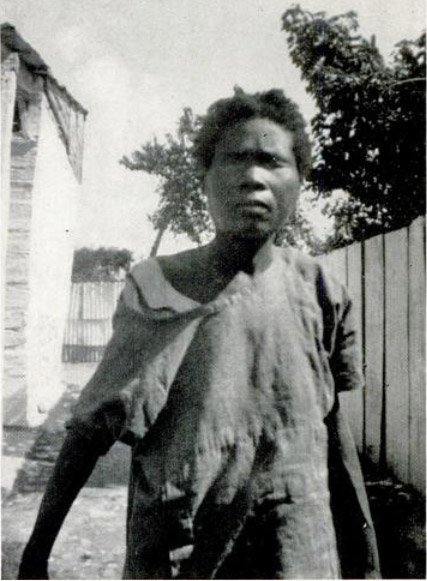1936, October 24: Felicia Felix-Mentor Returns
On October 24, 1936, an old naked woman with no eyelashes and a ragged cloth around her face wandered into the village of Ennery, Haiti. Panic spread through the village, and the news spread as well; and soon the Mentor family who lived just outside the village heard and investigated. It was said the strange woman was lame in her left leg... and she bore a resemblance to Felicia Felix-Mentor, who was also lame due to a fracture in her left leg. Felicia, however, had died and been buried in 1907, twenty-nine years earlier.
The woman was taken to a government hospital facility, and it was generally believed by the villagers of Ennery and the Mentor family that she was indeed the returned Felicia Felix-Mentor, having been turned to a zombie by a 'bokor' -- a Haitian magician -- then later abandoned. Famous author Zora Neale Hurston wrote of this returned Felix-Mentor as proof of the existence of zombies in Haiti, and even said that in a straightforward conversation with one of the doctors involved in the Felix-Mentor case that it had been stated there was a belief among the physicians that zombies were not the results of magic, but the results of some unknown drug that suppressed speech and free will in those exposed to it.

A zombie? [Larger version here]
Hurston took the photo of the woman reproduced here, and shared it to LIFE Magazine, which included it in their December 13, 1937, issue (where it was accompanied by a photo-spread of pictures documenting a 'Voodoo' ritual, taken by Rex Hardy Jr.). Hurston then published the known story of Felix-Mentor, along with her own belief in the existence of the drug that causes the condition, in her 1938 book, Tell My Horse.
Hurston's take on the situation, as well as her statements regarding the possible use of a drug to create zombies, were never taken seriously by doctors and other professionals. Hurston's previous books had shown that she had something of a taste for the fantastic, and that she was a ready believer of many folk tales she ran across; so scientists were not likely to treat her claims as credible to begin with.
In 1945, Louis P. Mars -- one of the doctors after whom the Centre de Psychiatrie et Neurologie Mars-Kline in Port-au-Prince was later named -- published an article in the anthropology journal Man, that detailed his discoveries regarding the woman being called Felicia Felex-Mentor. First off, he noted that she had been suffering from an eye disease at the time of her discovery, which had caused her eyelashes to fall out and given her extreme sensitivity to sunlight... which is why she had wrapped the ragged cloth around her head, and looked so odd. Next, he had found that x-rays showed the woman had no fracture in her left leg; her lameness was due entirely to dietary deficiencies, as was her apparent age. Once on a well-balanced diet, the woman regained her ability to walk, and soon looked much younger than when initially found... and she also began to menstrate again, which implied she was much younger than first supposed. Therefore the physical evidence, on the base of it, indicated she could not really be Felicia Felix-Mentor, as Felix-Mentor would actually be lame in the left leg, and noticeably older than the strange woman.
Mars then also went out of his way in his article to point out that this conclusion showed that Zora Neale Hurston's belief and assertion that this woman was a 'typical example' of zombies that existed in Haiti was mistaken and simplistic... which was unfortunate, for much of Mars' further finding about the woman may have supported her being one of the few cases of a recovered zombie, even though her original identity remained unknown. This is because in the same article, Mars stated the woman was unable to give any information about her identity, where she had been previously, or even about how she had gotten to the hospital. As he described it:
"All her answers were unintelligible and irrelevant. Her occasional outbursts of laughter were devoid of emotion, and very frequently she spoke of herself in either the first or the third person without any sense of discrimination. She had lost all sense of time and was quite indifferent to the world of things around her."
This description was attributed by Mars to schizophrenia; but it may also have been caused by a chemical alteration of normal brain activity... so this woman may have been exposed to the proposed drug that Hurston spoke of. Unfortunately, like almost every 'zombie' examined after her, with no positive proof to show the woman had been mistaken for dead at an earlier point, there was no motivation on the part of doctors to dig deeper than necessary to explain her behavior and condition.
Modern Mistaken Identities
This picture is often presented as being a shot of Clairvius Narcisse, a man now famous as a recovered zombie. Narcisse, however, wasn't turned into a zombie until 1962... 25 years after this photo was first published.
Anomalies -- the Strange & Unexplained, as well as my other website -- Monsters Here & There -- are supported by patrons, people like you! All new Anomalies articles are now posted for my patrons only, along with exclusive content made just for them. You can become a patron for just $1 a month!
|








